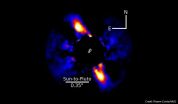Astronomers discover a young solar system around a nearby star
2015-06-02
(Press-News.org) An international team led by Thayne Currie of the Subaru Telescope and using the Gemini South telescope, has discovered a young planetary system that shares remarkable similarities to our own early solar system. Their images reveal a ring-like disk of debris surrounding a Sun-like star, in a birth environment similar to the Sun's. The disk appears to be sculpted by at least one unseen solar system-like planet, is roughly the same size as our solar system's Edgeworth-Kuiper Belt (commonly called the Kuiper Belt), and may contain dust and icy particles. This work provides a valuable key to understanding the early formation of the Sun and planets.
The discovery of the bright ring of orbiting the star HD 115600 changes everything, said Currie, a Subaru Project Fellow research astronomer. "It's kind of like looking at outer solar system when it was a toddler"
Remarkably, the ring is almost exactly the same distance from its host star as the Kuiper Belt is from the Sun (Figure 1), and it receives about the same amount of light. The star itself is just slightly more massive than the Sun and is a member of a massive grouping of 10- to 20-million-year-old stars called the Scorpius-Centaurus OB association. Its birth cloud is very similar to the nebula in which the Sun formed some 4.5 billion years ago.
There are strong indications that the ring around HD 115600 is being shaped by interactions with an unseen solar system-like planet. The team measured the position of the ring with respect to the star and found that the ring was significantly offset and has an eccentric shape (meaning that it's not very circular). This is likely due to the gravitational effect of a massive planet. The calculated eccentricity of the disk is among the largest known thus far, possibly more than the ring around the planet-hosting star Fomalhaut (which has at least one planet).
By using models that predict how planets of different masses and orbital separations shape a debris disk, the team calculated what kind of planet might be distorting HD 115600's ring. They found that eccentric versions of planets much like Jupiter, Saturn, Uranus, or Neptune could explain the shape and other properties of the ring.
Other clues suggest that the ring may have a composition similar to the Kuiper Belt. Its spectrum implies some types of dust, as well as major Kuiper Belt constituents such as ice and silicates. When compared with other debris disks, this one is much more efficient at scattering starlight, which implies it has a higher-reflecting, ice-like composition.
The discovery of the ring was made using the Gemini Planet Imager (GPI), an instrument dedicated to detecting planets and Kuiper Belt-like disks at never-before-seen scales. It is similar to the Subaru Coronagraphic Extreme Adaptive Optics (SCExAO) instrument currently being commissioned on the Subaru Telescope.
The results are very promising. "Even in just one of our many 50-second exposures, we could see what previous instruments failed to see in more than 50 minutes," Currie said. "Given this success with GPI, I'm very optimistic that Subaru's own, state-of-the-art planet-hunting instrument, SCExAO, will soon discover many Kuiper belt-like disks and young planets and will put us well on our way towards seeing another Earth."
Comparing the Kuiper Belt to HD 115600's Disk
Located just beyond Neptune's orbit, the Kuiper Belt contains numerous icy dwarf planets such as Pluto, Haumea, and Makemake. It is also home to thousands of remnants from the earliest stages of icy planet formation, and thus provides a key to understanding the early solar system.
The study of cold, Kuiper belt-like debris rings around nearby young Sun-like stars provides the best picture of what our own early, outer solar system might have been like. However, the few such rings that have been imaged so far haven't always been similar to ours. They usually surround stars much more massive than the Sun, or lie at greater distances than the Kuiper Belt, or are located in sparse star-forming regions unlike the massive and populous region in which the Sun was born. Until now, studies of these disks lacked the scattered-light spectra needed to explore them. Such studies can tell give information about the structure of the ring, as well as its motions.
The paper reporting these results is accepted for publication in The Astrophysical Journal Letters with a title "Direct Imaging and Spectroscopy of a Young Extrasolar Kuiper Belt in the Nearest OB Association"
INFORMATION:
[Attachments] See images for this press release:

ELSE PRESS RELEASES FROM THIS DATE:
2015-06-02
Using a brand new survey method, researchers in Bergen have asked a broad spectrum of people in Norway about their thoughts on climate change. The answers are quite surprising.
Some 2,000 Norwegians have been asked about what they think when they hear or read the words "climate change". There were no pre-set answers or "choose the statement that best describes your view" options. Instead the respondents had to formulate their views on climate change in their own words. The answers have provided striking new insight into what the average person on the street in Norway ...
2015-06-02
Long-term changes in immune function caused by childhood trauma could explain increased vulnerability to a range of health problems in later life, according to new research by the Institute of Psychiatry, Psychology & Neuroscience (IoPPN) at King's College London and the NIHR Maudsley BRC.
The study, published today in Molecular Psychiatry, found heightened inflammation across three blood biomarkers in adults who had been victims of childhood trauma. High levels of inflammation can lead to serious and potentially life-threatening conditions such as type-2 diabetes, cardiovascular ...
2015-06-02
Treatment options for chronic hepatitis C, a serious and life-threatening infection, have improved substantially and several new regimens with shorter durations and improved efficacy and safety profiles are now available.
Groups have raised concerns about the evidence used to support the approval of some newer drugs, however, and the issue has been used to cast doubt on their efficacy and even to question treatment or deny reimbursement.
To address these concerns, the US Food and Drug Administration's Division of Antiviral Products in the Center for Drug Evaluation ...
2015-06-02
This news release is available in French. Montreal, June 2 -- A new study published by the team of Naguib Mechawar, Ph.D., a researcher with the McGill Group for Suicide Studies (MGSS) of the Douglas Institute (CIUSSS de l'Ouest-de-l'Ile de Montreal) and associate professor in the Department of Psychiatry at McGill University, sheds new light on the disruption of astrocytes in depression. Astrocytes, a class of non-neuronal cells, have previously been implicated in depression and suicide.
However, it was not known whether these cells were affected throughout the brain ...
2015-06-02
Los Angeles, CA (June 2, 2015) Neighborhoods with more interpersonal conflict, such as domestic violence and landlord/tenet disputes, see more serious crime according to a new study out today in Journal of Research in Crime and Delinquency (JRCD). Private conflict was a better predictor of neighborhood deterioration than public disorder, such as vandalism, suggesting the important role that individuals play in community safety.
"Private conflicts, for example, domestic violence or friendship disputes over money or girlfriends, can and do spill over into public spaces, ...
2015-06-02
Scientists from the University of Louvain have discovered that a key element of infant brain development occurs years earlier than previously thought.
The way we perceive faces -- using the right hemisphere of the brain -- is unique and sets us apart from non-human primates. It was thought that this ability develops as we learn to read, but a new study published in the journal eLife shows that in babies as young as four months it is already highly evolved.
"Just as language is impaired following damage to the brain's left hemisphere, damage to the right hemisphere ...
2015-06-02
Children as young as 4 years old may reap better health from altruistic giving, a behavior that tends to be less common among kids from high-income families, according to new research on the nature and nurture of altruism published in Psychological Science, a journal of the Association for Psychological Science.
"The findings provide us with a new understanding of how children's altruistic behaviors, family wealth, and physiological health are intertwined," says psychological scientist and lead researcher Jonas Miller of the University of California Davis.
Previous ...
2015-06-02
EVANSTON, Ill. --- At a time when teenagers are grappling with new and often confusing health concerns, the overwhelming majority -- 84 percent -- turn to the Internet, according to the first national study in more than a decade to examine how adolescents use digital tools for health information.
But while most teens tap online sources to learn more about puberty, drugs, sex, depression and other issues, a surprising 88 percent said they do not feel comfortable sharing their health concerns with Facebook friends or on other social networking sites, according to the study ...
2015-06-02
CHARLOTTESVILLE, VA (JUNE 2, 2015). Researchers from the Canada North Concussion Network in Manitoba examined neuroimaging studies obtained in children and adolescents with sports-related concussions and found that the images appeared normal in 78% of cases. Detailed findings of this study are reported and discussed in "Neuroimaging findings in pediatric sports-related concussion" by Michael J. Ellis, MD, and colleagues, published today online, ahead of print, in the Journal of Neurosurgery: Pediatrics.
Expert opinion among physicians specializing in sports-related concussion ...
2015-06-02
CHARLOTTESVILLE, VA (JUNE 2, 2015). Researchers from the Canada North Concussion Network in Manitoba investigated the frequency of vestibulo-ocular dysfunction in children and adolescents with sports-related concussion and found that its presence was predictive of a prolonged recovery. Findings in this study are reported and discussed in "Vestibulo-ocular dysfunction in pediatric sports-related concussion" by Michael J. Ellis, MD, and colleagues, published today online, ahead of print, in the Journal of Neurosurgery: Pediatrics.
Normally, if you are asked to focus on ...
LAST 30 PRESS RELEASES:
[Press-News.org] Astronomers discover a young solar system around a nearby star

